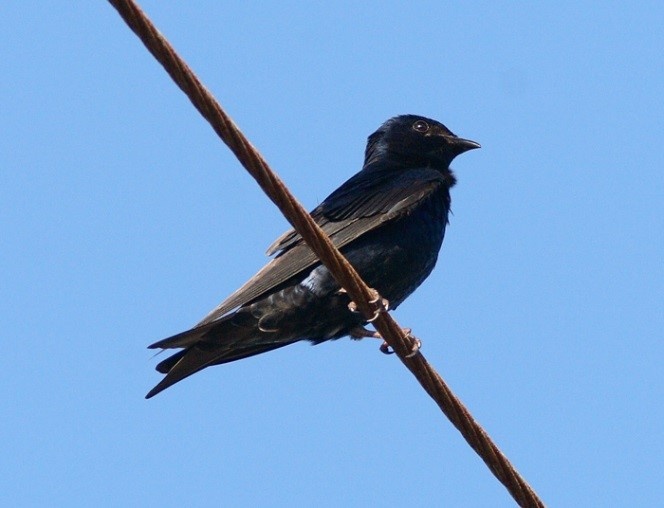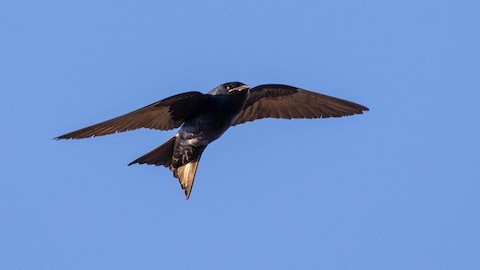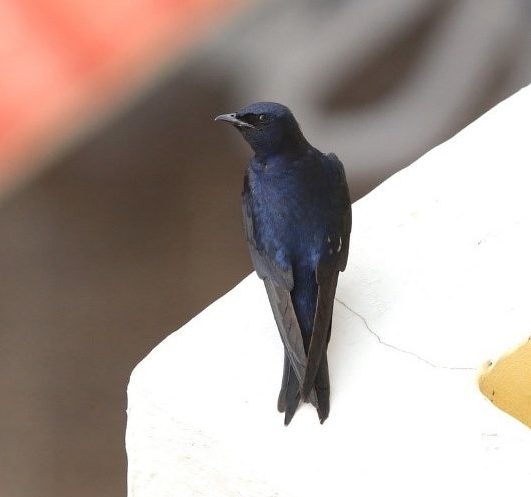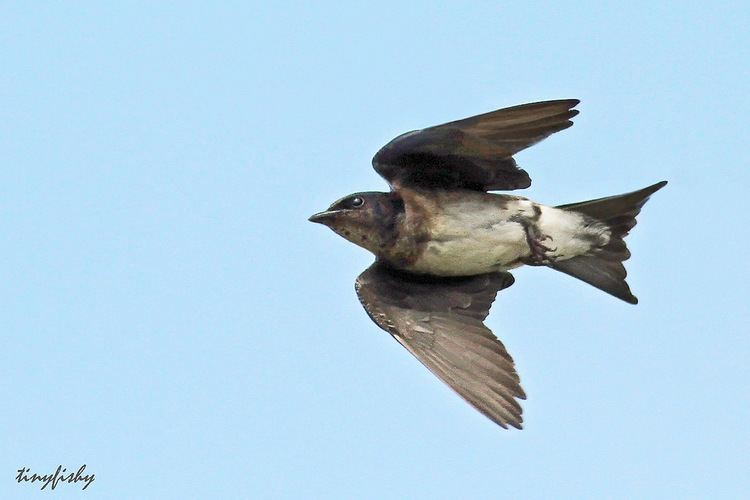Birdfinding.info ⇒ Locally common across Cuba from late February into October. Like several other Progne martins, it favors settled and coastal areas, so it is often found in seaside towns, where it habitually perches and nests on manmade structures. Can be found in Havana, on Cayo Coco, and at Playa Larga, among many other places.
Cuban Martin
Progne cryptoleuca
Family: Hirundinidae
Breeds on Cuba and some of its satellites, including the Isle of Youth, arriving around the end of February, and departing during late September and October. Typical habitat is mostly-open areas near water, often in agricultural and settled areas.
Nonbreeding range is unknown, but presumed to be northern or eastern South America, where it would be difficult to identify among the similar Progne martins.
Migrants have been observed on the ABC Islands (confirmed by three specimens taken on Curaçao in 1955 and 1956), and also reported from Puerto Rico and the Lesser Antilles.
Identification
Male is glossy indigo-black overall, generally indistinguishable from male Purple Martin.

Cuban Martin, male. (April 5, 2008.) © William Price

Cuban Martin, male, showing some white on the lower belly. (Camagüey, Cuba; March 24, 2018.) © Mel Senac

Cuban Martin, male. (Havana, Cuba; June 7, 2018.) © Tim Norriss

Cuban Martin, male. (Havana, Cuba; July 6, 2014.) © Karl-Heinz Dohlich
The species name cryptoleuca (“hidden white”) refers to white on the belly feathers of adult males that is typically visible only in the hand when the feathers are ruffled.
Many individuals, especially first-year birds, show whitish and ashy-brown feathers on the belly and vent, to widely variable extents, and many appear to be all-dark.

Cuban Martin, likely first-year male with windblown feathers showing extensive white from the belly up to the chest. (Matanzas, Cuba; March 5, 2011.) © Dave Irving

Cuban Martin, first-year male showing extensive whitish and gray feathers on the belly and mid-breast. (Cayo Coco, Cuba; April 11, 2014.) © Greg Griffith

Cuban Martin, first-year male showing extensive white and gray feathers from the belly up to the chest. (Sendero Las Salinas, Playa Larga, Matanzas, Cuba; April 10, 2019.) © Michael J. Good

Cuban Martin, first-year male showing extensive whitish and gray feathers from the belly up to the chest. (Sendero Las Salinas, Playa Larga, Matanzas, Cuba; April 10, 2019.) © Michael J. Good
Females and immatures have dark upperparts, often extensively infused with a glossy bluish sheen. Their underparts are mostly white from the breast to the vent, and ashy-brown on the throat, chest, and sides. On females the forehead is typically ashy-brown, matching the throat.

Cuban Martin, female showing ashy-gray on underparts limited to the throat, chest, and sides. (La Cuchilla, Cienfuegos, Cuba; April 14, 2016.) © Kurt Hennige

Cuban Martin, female. (Cuba; April 5, 2008.) © William Price

Cuban Martin, female. (Guantánamo Bay, Cuba; January 23, 2018.) © Wayne Fidler

Cuban Martin, female with fledgling in nest. (Playa Larga, Matanzas, Cuba; May 26, 2014.) © Arnaude Delberghe

Cuban Martin, female showing extensive ashy-gray on the breast—note matching forehead coloration. (Cayo Coco, Cuba; March 5, 2018.) © Joseph Dylke

Cuban Martin, female. (Holguín, Cuba; June 10, 2013.) © tiny fishy
Cf. Purple Martin. Male Purple and Cuban Martins are not reliably distinguishable, with the possible exception of first-year Cubans, which generally have more extensively pale underparts than first-year Purples.
Females of the two species are also very similar, and confusing due to the variability of female Purples. In general, female Cuban typically has a clear demarcation between the white breast and dark throat and chest, whereas female Purple shows less contrast: the throat is usually paler than Cuban’s and the breast has more extensive ashy coloration. Many female Purple Martins have a noticeably pale collar, which does not seem to be a feature of female Cubans.
Cf. Southern Martin. Male Southern and Cuban Martins differ vocally but are not reliably distinguishable by sight, with the possible exception of first-year Cubans, which generally have more extensively pale underparts than first-year Purples.
Female Southern Martin is more distinctive than most Progne martins, as it has almost uniformly dark gray underparts, with whitish scaling on the belly.
Cf. Caribbean Martin. Female Caribbean and Cuban Martins can be nearly identical, and variation in both species makes it difficult to isolate any distinctions between them. Female Caribbeans on the dark end of the spectrum tend to show the same underparts pattern as male Caribbeans: i.e., the sides are dark and the white area in the mid-breast is narrower than on female Cubans.
Notes
Monotypic species. Some authorities have classified Cuban Martin as a subspecies of Purple Martin. This seems reasonable based on their strong overall resemblance, but would probably be best evaluated through a close analysis of the differences (especially in their voices and female plumages) among the populations currently classified as Purple Martins.
References
Alderfer, J., and J.L. Dunn. 2014. National Geographic Complete Birds of North America (Second Edition). National Geographic Society, Washington, D.C.
eBird. 2019. eBird: An online database of bird distribution and abundance. Cornell Lab of Ornithology, Ithaca, N.Y. http://www.ebird.org. (Accessed October 11, 2019.)
Raffaele, H., J. Wiley, O. Garrido, A. Keith, and J. Raffaele. 1998. A Guide to the Birds of the West Indies. Princeton University Press, Princeton, N.J.
Ridgely, R.S., and G. Tudor. 1989. The Birds of South America, Volume I: The Oscine Passerines. University of Texas Press, Austin.
Turner, A. 2019. Cuban Martin (Progne cryptoleuca). In: del Hoyo, J., Elliott, A., Sargatal, J., Christie, D.A. & de Juana, E. (eds.). Handbook of the Birds of the World Alive. Lynx Edicions, Barcelona. https://www.hbw.com/node/57710. (Accessed October 11, 2019.)
Wells, J.V., and A.C. Wells. 2017. Birds of Aruba, Bonaire, and Curaçao. Cornell University Press, Ithaca, N.Y.
